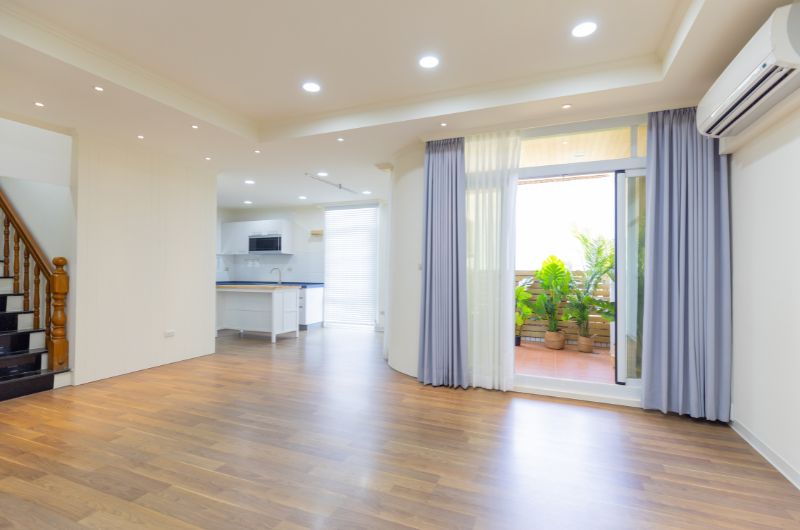As winter settles in and temperatures fall, many homeowners notice just how cold their floors can become. Even a well-heated home can feel chilly if the flooring doesn’t hold warmth or provide proper insulation. The right flooring choice can dramatically improve comfort, reduce heat loss, and make a home feel genuinely welcoming through the colder months. So, what is the best flooring for a cold house? The answer depends on your balance between warmth, practicality, and style.
Carpet & Underlay is still the Cosiest Option for Cold Homes
Carpet remains the warmest flooring solution thanks to its ability to trap heat within its fibres. When paired with a high-quality underlay, it forms an effective insulating barrier between you and a cold subfloor. This makes it particularly well-suited to bedrooms, lounges, and spaces where comfort is important.
It also provides a soft and luxurious feel that adds an immediate sense of warmth. Although carpet requires regular cleaning and cannot be used in wet areas, it continues to be the most reliable choice for maximum thermal comfort.
Luxury Vinyl Plank as a Practical, Warm and Stylish Alternative
Luxury vinyl plank (LVP) has become a favourite in colder homes because it offers warmth, durability, and moisture resistance in one package. LVP generally feels warmer than ceramic tile and often includes built-in underlay that reduces cold transfer from the subfloor.
Its waterproof properties make it practical for kitchens, hallways, and basements, while the realistic wood and stone designs give the look of natural materials without the chill. Thicker, higher-quality LVP products tend to offer better warmth and comfort through the winter months.
Engineered Hardwood for Natural Warmth and All-Season Stability
For those who love the look and feel of real wood, engineered hardwood offers a warm and stable option for cold environments. Wood naturally feels warmer underfoot than materials such as tile, and engineered boards are constructed in layers to cope better with temperature changes.
They work well in living rooms, dining areas, and bedrooms, and they pair particularly effectively with underfloor heating systems. Although engineered hardwood should be avoided in very damp spaces, it remains a stylish and comforting solution for much of the home.
Laminate Flooring: A Budget-Friendly Way to Keep the Chill Away
Laminate flooring can perform surprisingly well in cold houses, especially when combined with the right underlay. Modern laminate is typically installed over foam or cork underlay, which adds insulation and reduces the transfer of cold from hard surfaces beneath.
While laminate does not offer the same warmth as carpet or engineered wood, it provides a good balance of comfort, practicality, and affordability. It’s ideal for everyday living areas, bedrooms, and offices, and water-resistant versions are available for kitchens and utility rooms.
Tiles with Underfloor Heating – Possibly The Ultimate Combination for Warmth
Tile is naturally one of the coldest flooring materials, but when paired with underfloor heating, it becomes one of the warmest and most luxurious options available. Radiant heating systems warm the entire tile surface evenly, creating a steady and efficient heat source that transforms bathrooms, kitchens, and entryways.
Although this system requires a greater upfront investment, many homeowners find the comfort and energy savings well worth it. Without heating, tile remains cool, but with it, it can outperform every other flooring type for winter comfort.
How These Flooring Types Compare in a Cold Home
Without any heating system underneath, carpet remains the warmest flooring option, followed by engineered hardwood, luxury vinyl plank, laminate, and finally tile. When underfloor heating is introduced, tile moves to the top of the list as the warmest and most efficient solution.
Flooring also plays an important role in energy efficiency. Good insulation reduces heat loss and keeps indoor temperatures stable, which can help lower heating bills. Underlay can significantly improve overall warmth, especially when using cork, foam, or rubber-based products.
Choosing the Best Flooring for Your Cold House
The right flooring depends on your priorities. For unbeatable warmth and softness, carpet is the clear winner. For a blend of warmth, durability, and moisture resistance, luxury vinyl plank offers a versatile and practical choice.
If you prefer natural warmth with a high-end look, engineered hardwood is effective and stylish. Laminate provides a cost-effective middle ground, offering decent warmth at a lower price. And for those seeking ultimate comfort, tile combined with underfloor heating creates a perfectly warm home environment throughout the winter.



